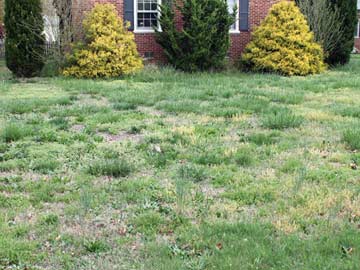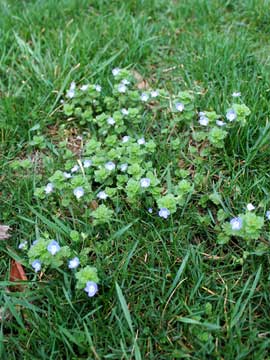 Creeping charlie, also known as ground ivy, is one of the worst of the creeping lawn weeds.
Creeping charlie, also known as ground ivy, is one of the worst of the creeping lawn weeds.
© George Weigel
The occasional dandelion can be dug out of lawns, and crabgrass is fairly easy to stop by applying a crabgrass preventer each early spring. But weeds that creep through a lawn – especially fast-spreading, root-as-they-go ones that come back every year – are the ones that really cause frustration. These include such common invaders as chickweed (little white flowers), creeping speedwell (blue flowers), wild strawberry (white flowers and tiny red fruits), mugwort (scalloped leaves, pink-purple flowers), bindweed (tubular white flowers) and the king of lawn annoyance—creeping charlie. Also called ground ivy (among a handful of regional nicknames), creeping charlie is a mint-family plant and one-time beer ingredient that has light-purple flowers and glossy, rounded leaves with scalloped edges. These annoying, creeping weeds all have the potential to mat their way over top of turfgrass, ultimately smothering the lawn. If they’re thriving in your lawn, it’s generally a sign that your lawn isn’t in ideal shape in the first place.
 Lawns with poorly performing grass are an open door to weed infestation.
Lawns with poorly performing grass are an open door to weed infestation.
© George Weigel
Weeds are opportunists. Bare dirt is their ally. So the best long-term solution is to keep the grass as thick and healthy as possible so weeds can’t elbow their way into the planting. In other words, if you beat them to the punch by getting grass there first, you win. If you’re losing that battle, your fight begins with getting rid of the creepers you have.
Identifying the weed, is an important first step. There are numerous online sources to help you do that. Once you know the enemy, check the herbicide label to make sure that product is listed as effective against the weeds you have. We recommend several products with herbicides that kill most broadleaf weeds, including creeping charlie, without harming lawn grass. GreenView Broadleaf Weed Control plus Lawn Food is an excellent option, when you want an all in one weed treatment and fertilizer. Preen Lawn Weed Control is exclusively for lawn weed control, effective on creeping charlie—and a great option when an additional fertilizer application is not needed.
 Creeping weeds such as this creeping speedwell can quickly overtake a lawn because stems root as they go.
Creeping weeds such as this creeping speedwell can quickly overtake a lawn because stems root as they go.
© George Weigel
Although herbicides are effective any time a treatable weed is actively growing, one of the best windows for perennial creepers like creeping charlie, wild strawberry and bindweed is early fall. That’s when these weeds are beginning to transfer energy to the roots for winter and when they’re more vulnerable to herbicide action. So if your first try at killing a creeper isn’t very effective, try again at a different time. It’s also not unusual for some of the tougher weeds to need two or three treatments before they finally give up. Follow the label for how often applications can be made.
By eliminating existing weeds, you’ll clear the soil and pave the way to fill the space with new grass seed. Once the creepers are knocked back, get new grass in place as soon as the herbicide label says it’s OK – usually within a few weeks. Early fall and early spring are two ideal times to plant grass seed, but it can sprout any time during the growing season so long as the ground is kept consistently damp.
Then it’s a matter of “playing good defense” to encourage grass to grow as quickly and thickly as possible to head off any weedy return.